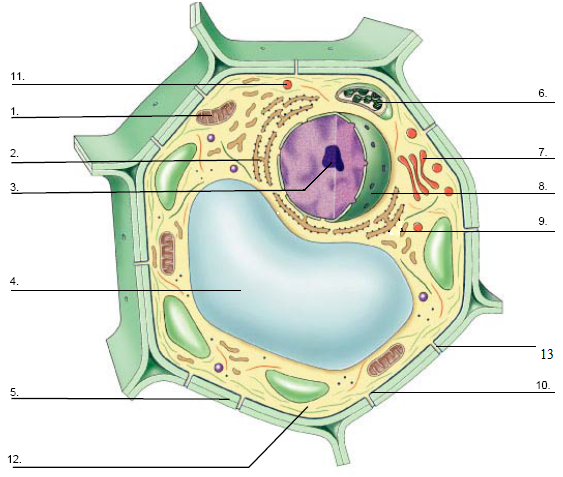Which organelle is responsible for energy production in both plant and animal cells?
Mitochondrion
Which sequence is correct in the organization of life?
B. Cell → Tissue → Organ → Organ SystemChlorophyll
Which macromolecule is the main source of energy?
Carbohydrates
What is the product of the Calvin Cycle?
Glucose
What are these tiny green dots in the plant cell?:max_bytes(150000):strip_icc():format(webp)/plant-cell-elodea--isotonic-solution-shows-cells--chloroplasts-250x-at-35mm-139802547-5a956de86bf069003717851a.jpg)
Chloroplasts.
What structure is found only in plant cells??
Cell wall
Homeostasis involves:
Maintaining internal stability
What are the building blocks of proteins?
Amino acids
The light-dependent reactions occur in which part of the chloroplast?
Thylakoid membranes
What would be number 1 be on this plant cell diagram?

Cell Wall
What particles make up atoms?
Protons, neutrons, electrons
Glycolysis occurs in:
Cytoplasm
Carbon is known for its ability to form how many covalent bonds?
4
What gas do plants take in during photosynthesis?
Carbon dioxide (CO₂)
 What is number 3 on this plant cell diagram?
What is number 3 on this plant cell diagram?
Cytoplasm
Which organelle contains the cell’s DNA?
Nucleus
What is the main energy molecule produced by cellular respiration?
ATP
Lipids are mainly composed of which elements?
Carbon, hydrogen, and oxygen
What do plants release as a byproduct of photosynthesis?
Oxygen (O₂)
What is number 4 on this plant cell diagram?
Vacuole
Which macromolecule stores genetic information?
Nucleic acids
Which cycle produces carbon dioxide in cellular respiration?
Krebs Cycle
Which macromolecule provides structural support in plant cell walls?
Cellulose (a polysaccharide)
What energy molecules are produced during the light-dependent reactions?
ATP and NADPH
Which number on this diagram is pointing to the endoplasmic reticulum?

Number 7